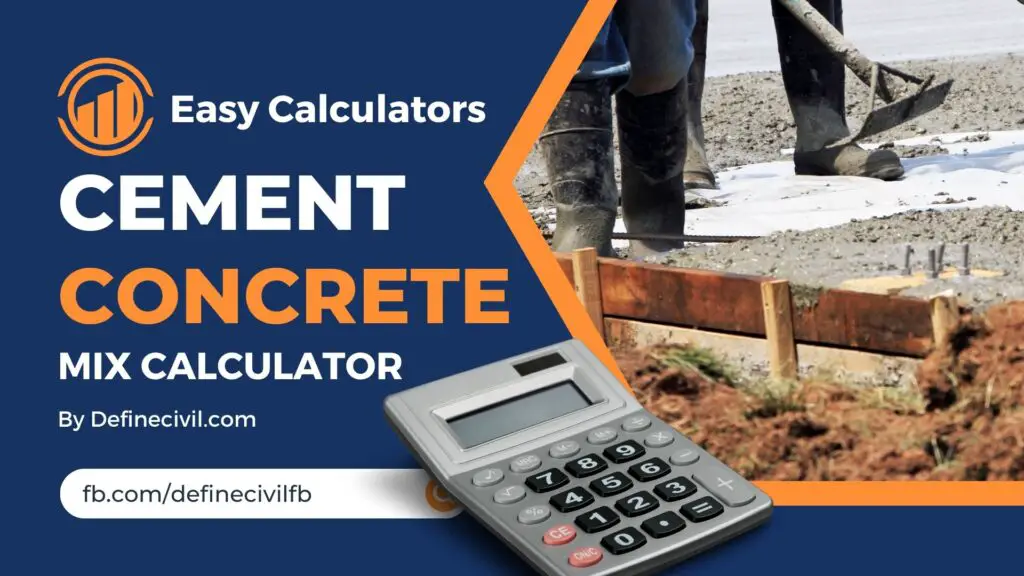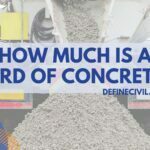Are you looking to determine how much cement, sand, and aggregate you require for a specific grade of concrete. This online calculator will help you accurately determine every component of concrete as per the selected mix design from the list.
The calculator is pretty easy to use for estimating cement, sand, and aggregate in a batch quantity. You will just supply the dimensions of the concrete slab or concrete column or beam or may be footing. The calculator will give you result in terms of cement bags, cement volume.
So, if you know the dimension of the concrete member and want to know how much concrete quantity do I need; this calculator will help you.
Whether you need to estimate the concrete materials for 1:2:4 or other mix design like 1:2:3, the concrete calculator app will help you in all the steps. Want to know how to calculate cement, sand and aggregate quantity; below I have explained in depth the estimation process.

Concrete estimation is never that easy when you have this online concrete estimation calculator. You’ll be able to confidently order the right amount of cement next time you’re looking to start your next project!
Concrete Mix Calculator
Below is the calculator:
Steps to calculator concrete quantity
An essential aspect of constructing a concrete structure is to know how much concrete mix you will need. This will help determine what sort of truck and equipment you will require and whether or not you have enough manpower available to lay all that concrete in one day. A small, residential house may only require 500–1000 m3 (or cubic meters) while a large apartment complex could need upwards of 30,000 m3.
Also Read: How much is a yard of concrete? – With Bonus tips to save money
Know your project
Before you can calculate how much concrete you need, it’s important to figure out what kind of project you’re working on. Simply put, different jobs require different amounts of concrete. For example, a walkway is going to require less amount cement and concrete than a foundation.
Also Read: How Much Does A Floor Plan Designer Cost?
Determine the mix-design
Since we don’t know what type of job we’re looking at or how big it is—which makes planning tricky—let’s say our project involves one cubic yard (27 cubic feet) of concrete. In order to calculate how much cement we need, we must first determine its composition by reading its mix design.
Know the dimensions
For concrete slab, you need to know the length, width, and thickness. For column, you need to know the cross-section area and the height of the column. For beam, it is the same with the span of the beam. For circular column, you need to know the diameter for the column to determine the cross-section area.
Also Read: 9 Types of Concrete Cracks (With Pictures)- Tricks to Prevent – PDF
Calculate Volume
Determine how much volume you’ll need. If you’re not sure, you can use an equation for cubic yards: (depth) x (width) x (length). For example, if you have 5 feet in depth, 15 feet in width and 20 feet in length, that would be 625 cubic yards. If you don’t want to calculate it yourself, just enter your values above and the calculator will give you the concrete—most sell concrete mix by volume.
Also Red: Weight of concrete per cubic foot – With Examples – (Including Calculator)
What is concrete?
Concrete is a combination of cement, water and aggregates (such as sand or gravel). Calculating the amount of cement, aggregate, and sand you’ll need to make concrete can be tricky if you don’t have the right tools, but it’s easier than you think once you know how to do it. Use the above estimator with simple steps to calculate how much cement to add, and your end product will be guaranteed to stand up to whatever test you give it.
Also Read: Concrete Definition – 3 Basic Components – Grades
What is RCC?
Most concrete is reinforced by steel, so it’s also called reinforced concrete. Concrete with steel rods in it can be poured continuously through a form and is known as reinforced continuous. Concrete made using wire mesh or expanded metal instead of rebar is reinforced cage, but many people just call it reinforced concrete anyway. RCC differs from regular concrete in that cement only hardens under tension while RCC hardens under both tension and compression.
Further Read: 17+ Aggregate – Types – Properties (Must know)

















